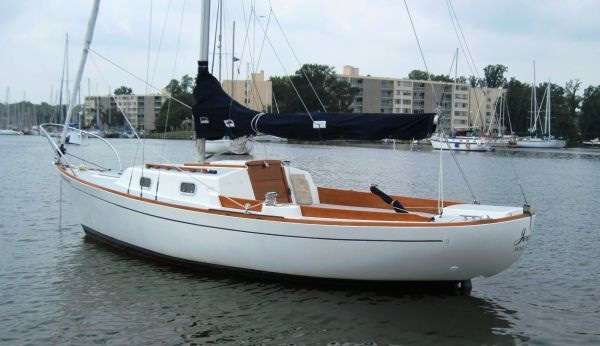How did I miss this little gem for so many years?
A week or so ago, I had a call from a friend who was looking to replace the cruising boat he had recently sold with something smaller that he could use as a daysailer and occasional weekend cruiser. He was attracted to the large cockpit and accommodations of the Sailmaster 22, but had concluded these aging centerboard models were too high-maintenance. The Cape Dory 25 appealed to him aesthetically, but he felt the cockpit was too small and uncomfortable to make a good daysailer. I asked him if he’d considered a Quickstep 24, to which he responded, “What’s a Quickstep 24?” This one is for you, Buck.
The Quickstep 24 was designed by Ted Brewer in the late 1970s and was originally intended for aluminum construction, which never quite worked out. Eventually, the design caught the eye of Rhode Island sailor and boat builder Bill Stanard, who purchased the rights for fiberglass production.
With moderate freeboard, a pronounced sheer line, canoe stern, and a nearly full keel with attached rudder, the Quickstep 24 as a conservative design. As is Brewer’s tradition, the keel is cut away significantly at the forefoot with a second “bite” taken out just forward of the rudder. By doing this, wetted surface and the drag associated with it are lessened and the lateral plane reduced so there is less resistance to turning and less tendency to stall halfway through a tack.
From 1977 to 1990, the Quickstep 24 was built by at least four different New England builders, including Stanard Boat Works, C.E. Ryder Corp., The Anchorage, and Shannon Boat Company. Prior to Shannon taking over production, the Quickstep’s hulls were built using woven roving, chopped strand mat and polyester resin. Shannon chose more current unidirectional and bidirectional fiberglass materials and used Vinylester resin for the first layer of laminate below the waterline to help mitigate osmotic blistering. All Quickstep hulls are solid fiberglass laminates, while decks are balsa cored. The deck and hull are joined on an inward flange with a combination of sealant and mechanical fasteners closely spaced. These are well-built production boats that have held up well with reasonable care and maintenance. Dark blue and dark green gelcoated hulls were popular choices among many first-time owners. Older boats, particularly those with dark colored hulls, are likely to need a paint job to restore a yacht-like appearance.
On a small boat, it’s tough to get too creative or incorporate too many features into a deck arrangement, but the Quickstep has several features worth mentioning. First, there is a huge cockpit which comfortably accommodates four adults and allows passengers to sit far enough forward so that, even with four or five people aboard, the boat can be sailed without the transom dragging through the water. Secondly, most Quickstep 24s have halyards led to the cabin top so that the boat can be sailed without leaving the safety of the cockpit.
The Quickstep 24 is sometimes described as a “pocket cruiser,” but this is a stretch. I think it’s best described as a daysailer with overnight capabilities. The cabin features a V-berth forward adequate for two normal-sized adults. There are port and starboard quarter berths suitable for children but more commonly used for storage. Some models sacrificed the port quarter berth in favor of a storage locker accessible from the cockpit seat. Galley facilities are minimal and the head is in the V-berth area and offers no privacy.
Although early models had the option of an inboard diesel engine, I think it is safe to say the vast majority of Quickstep 24s are powered by outboards—usually ranging from six to 9.9 horsepower. Outboards are mounted in a lazarette well, which places them on centerline and further forward than if transom-mounted. This results in less pitching moment and less tendency to pop out of the water in choppy seas but has the disadvantages of not being able to be raised clear of the water when not in use and sacrificing storage space.
The Quickstep’s displacement length ratio is 260, certainly moderate for a full keelboat of this length, and the sail area/displacement ratio is a modest 16.4. The Quickstep 24 is considered a fairly stiff boat owing to a ballast/displacement ratio of 48 percent. That said, a 1978 manufacturer’s brochure lists a displacement of 3300 pounds and ballast of 1300 pounds for a 39 percent ratio. I would expect these boats to be quite tender; although, my research suggests that only hulls number one and two were built to these lighter specifications. The sail area is well balanced, and by all reports, this is a great sailing little boat.
Somewhere in the neighborhood of 200 Quickstep 24s were built, all by New England builders, so their numbers tend to be concentrated from New England through the Mid-Atlantic States. In late June, there were six boats offered for sale by yachtworld.com. Five offerings were in the aforementioned area, while the sixth was in Canada. Asking prices ranged from $11,000 to $15,700, and the two highest priced included over-the-road trailers.
Five, mid-to-late 1980s Quicksteps have been reported sold over the last year with an average selling price of $9700. None of the recently sold boats had trailers.
Whether it’s for my friend or anyone else for that matter, I am hard-pressed to think of a daysailer/weekender in this size and price range that I would recommend over a Quickstep 24.
About the Author: Jack Hornor, N.A., is the principal surveyor and senior designer for the Annapolis-based Marine Survey & Design Co. msdco.com
Specifications:
LOA 23’ 11”
LWL 19’
Beam 7’ 11”
Displacement 4000 lbs.
Draft 3’ 4"
Reviewed in the July 2009 issue of SpinSheet by Jack Hornor





